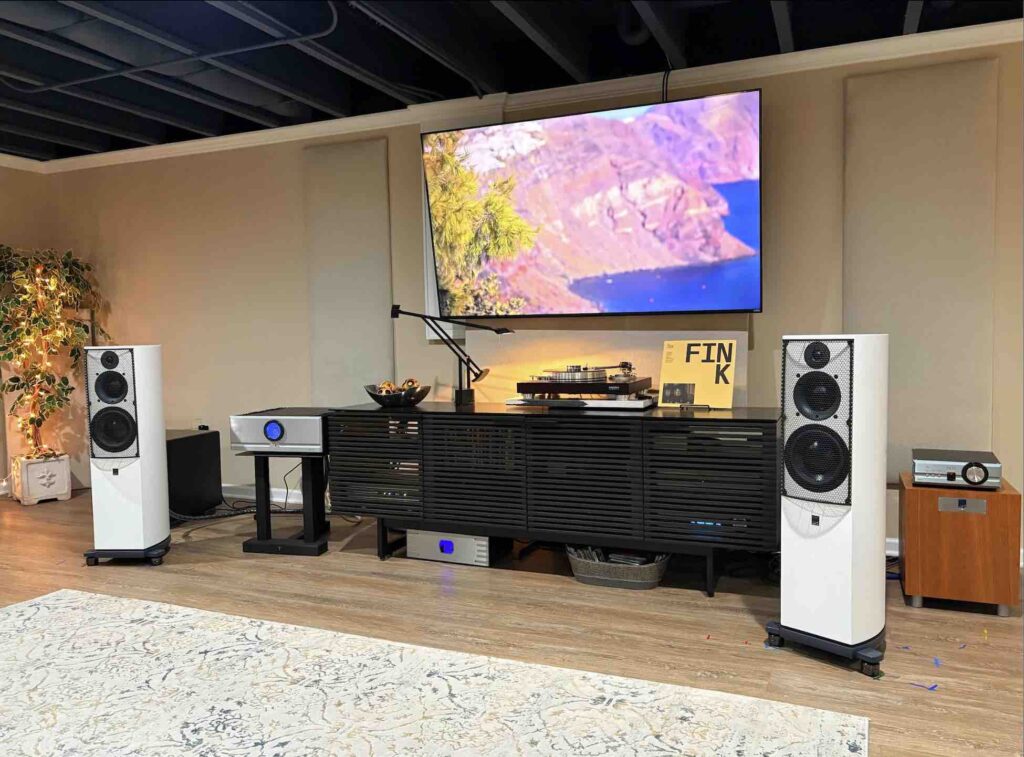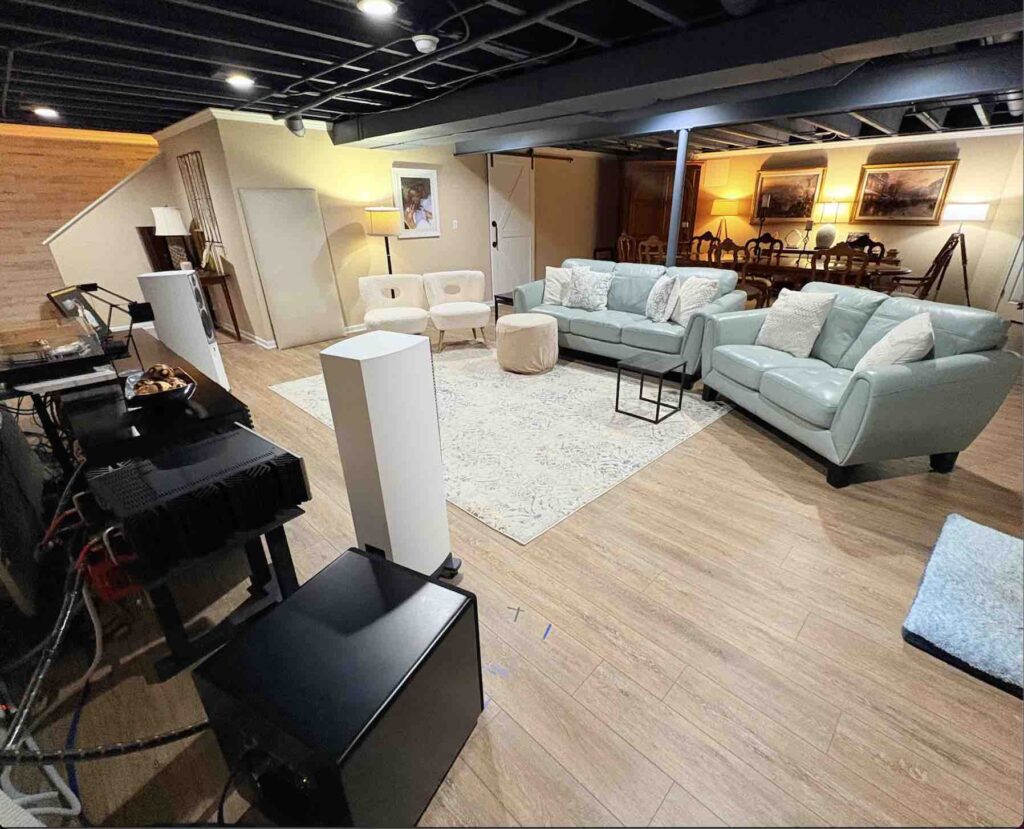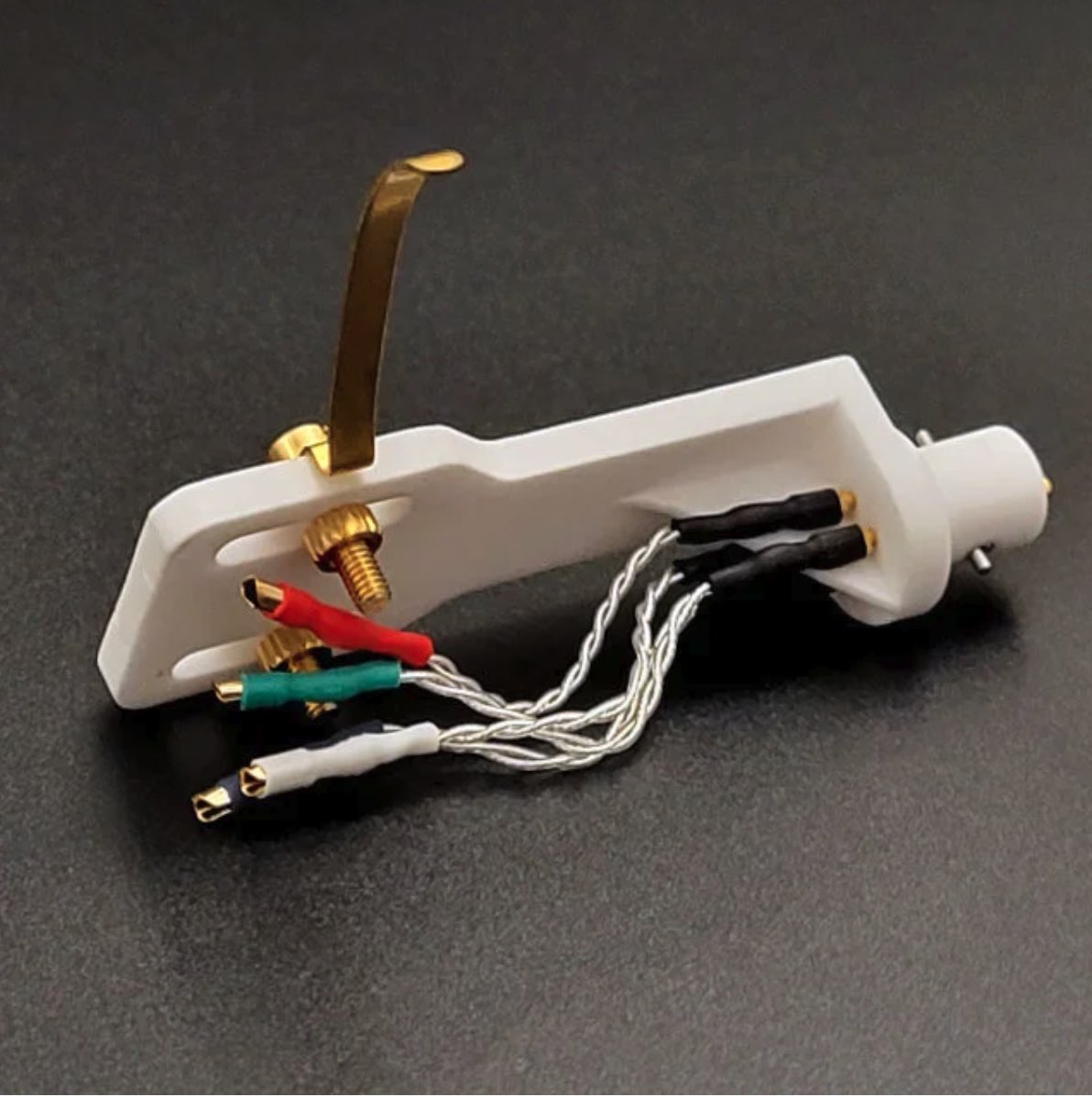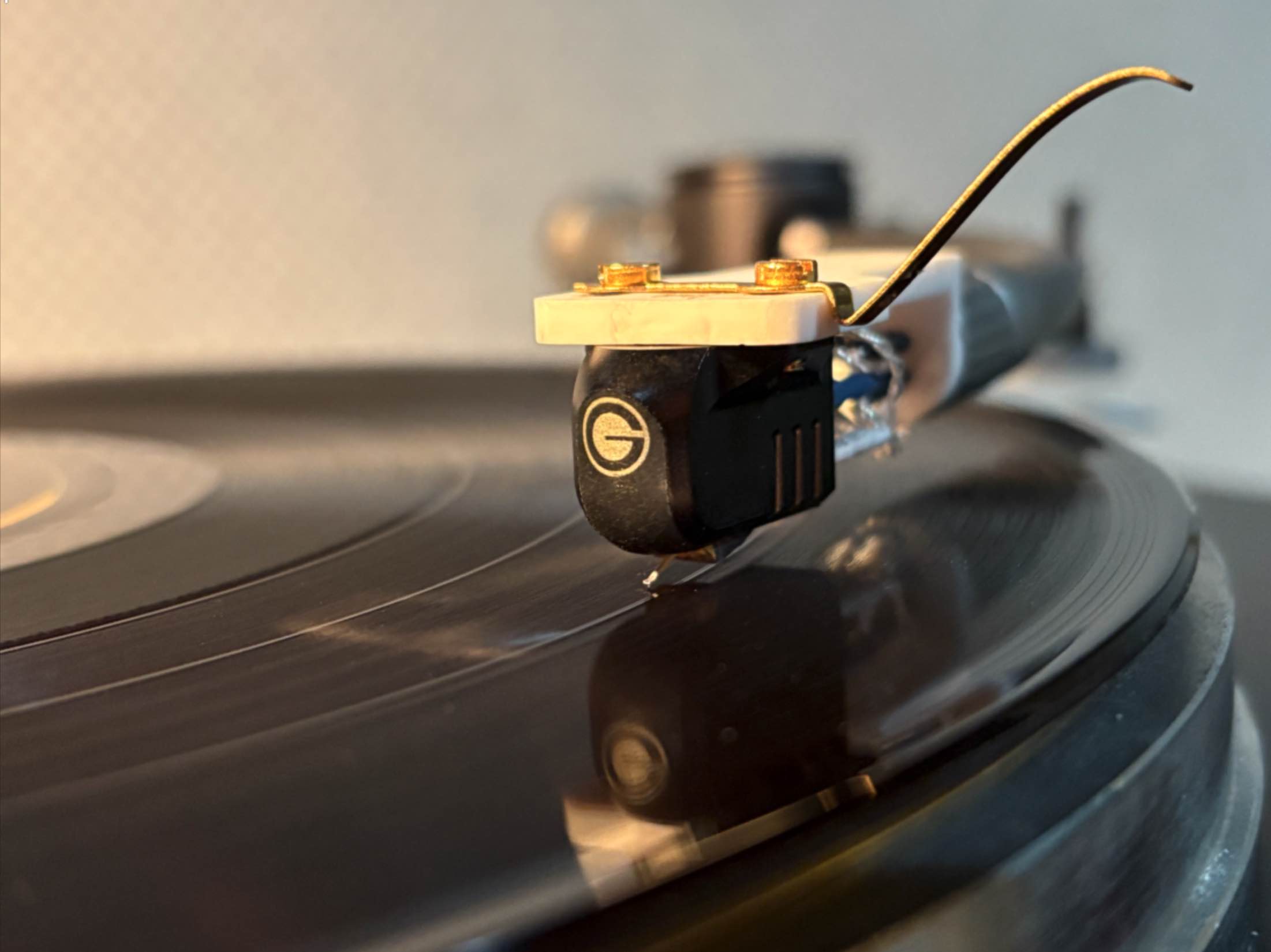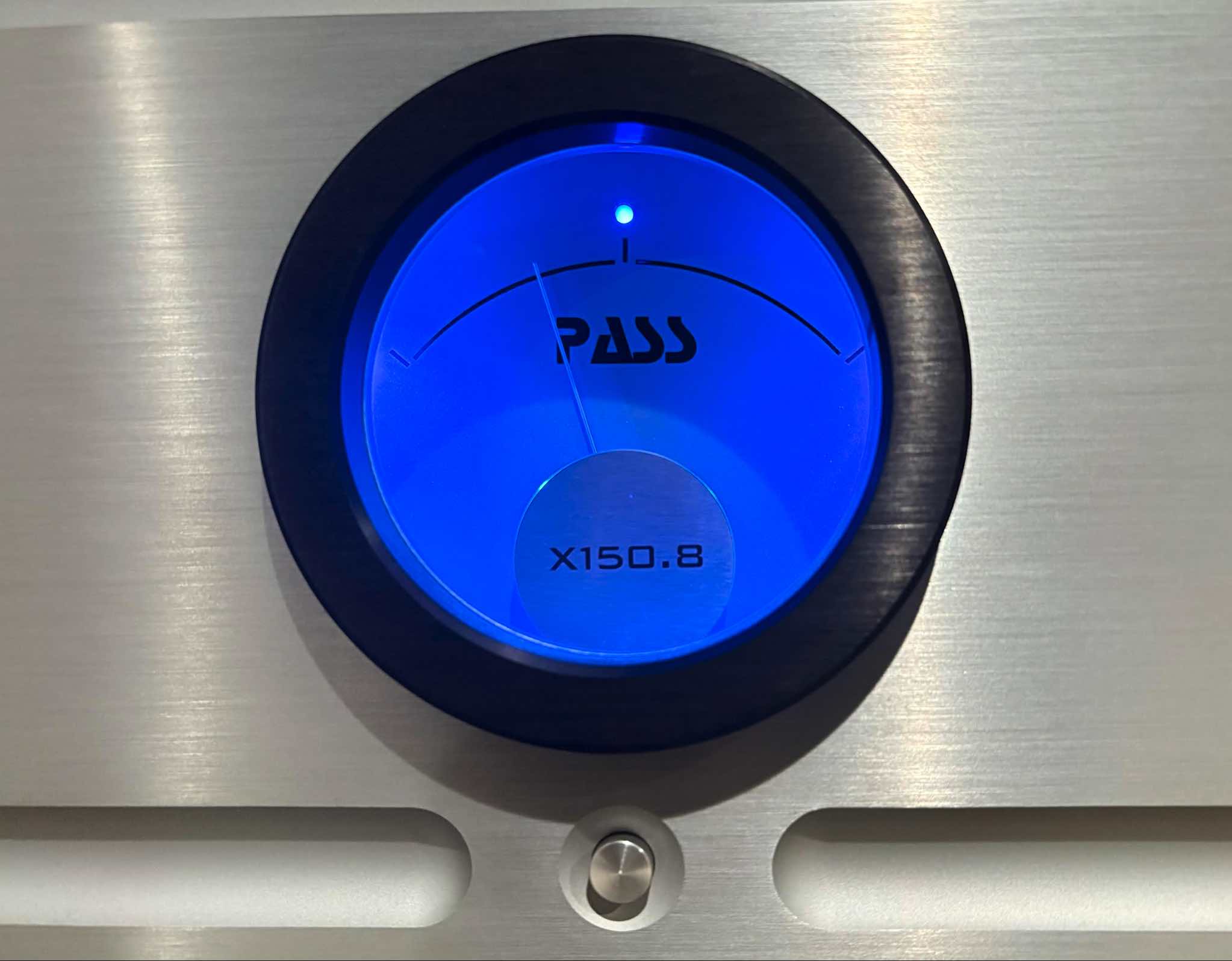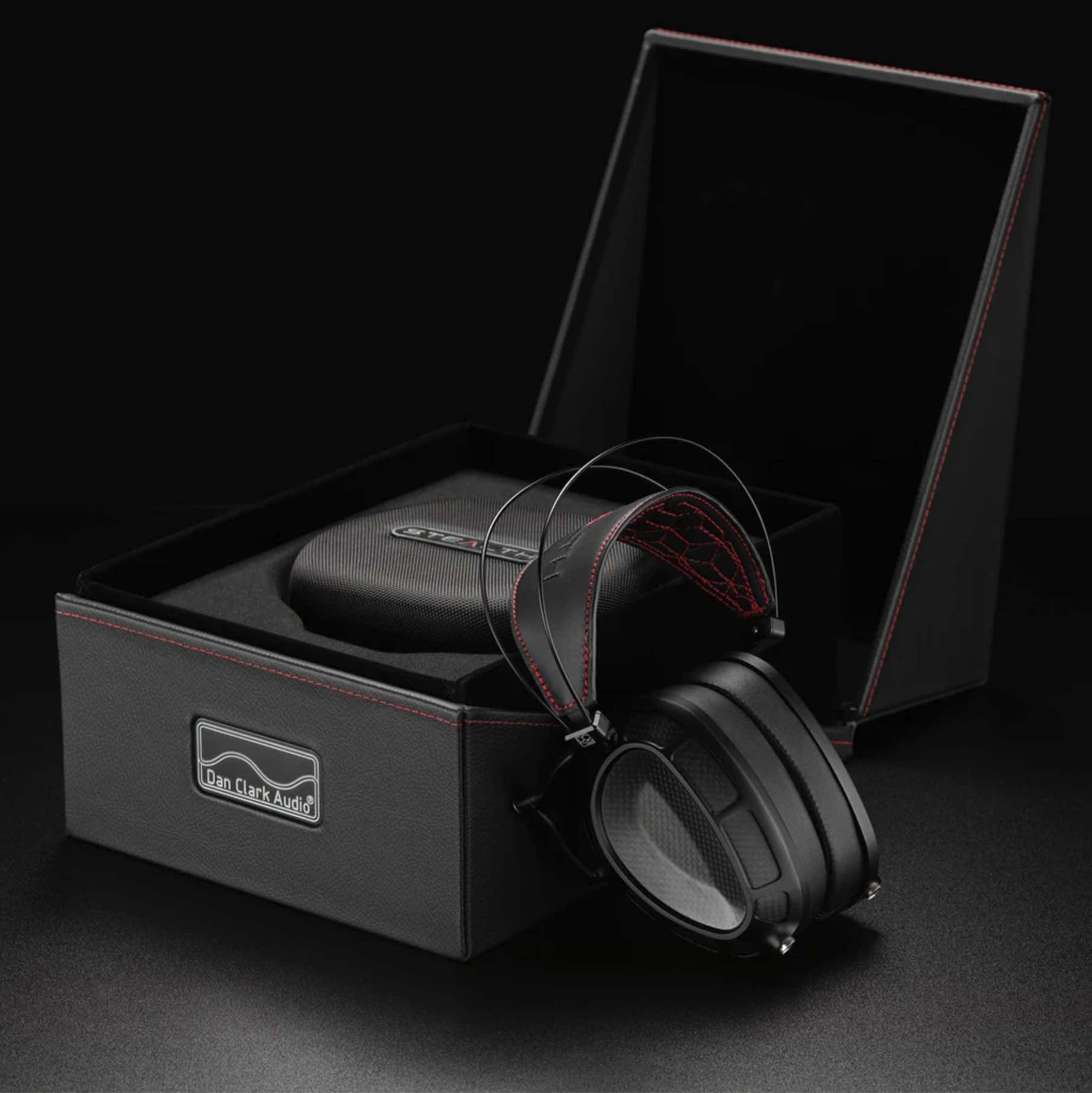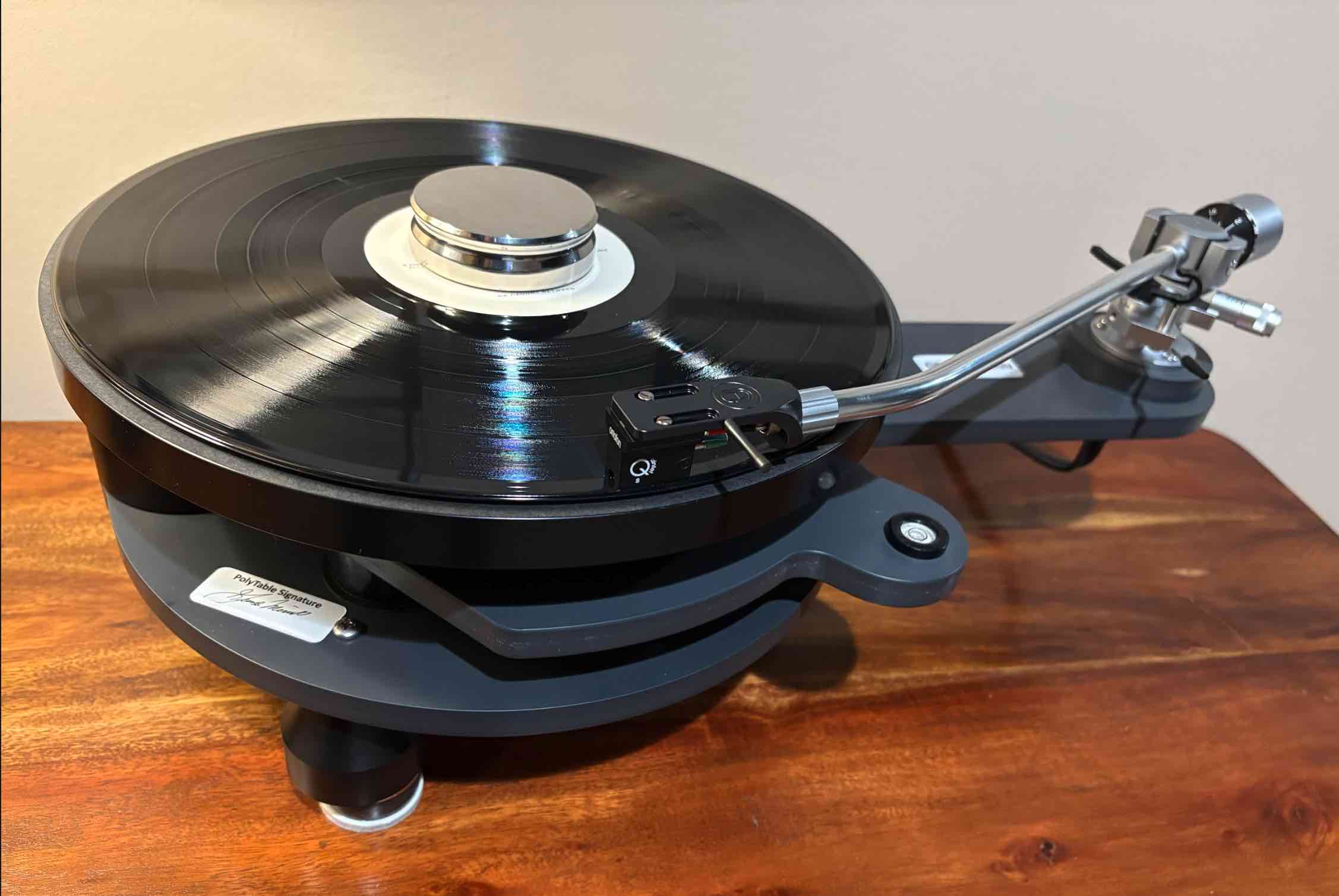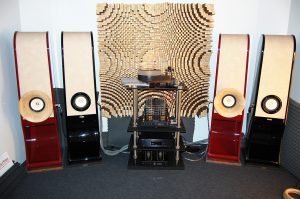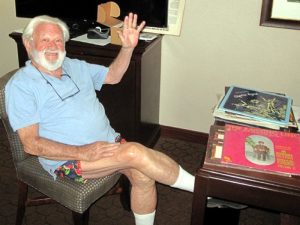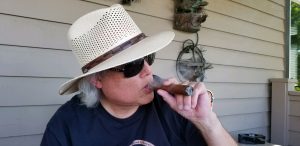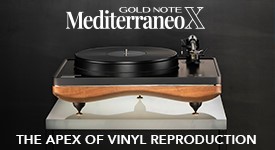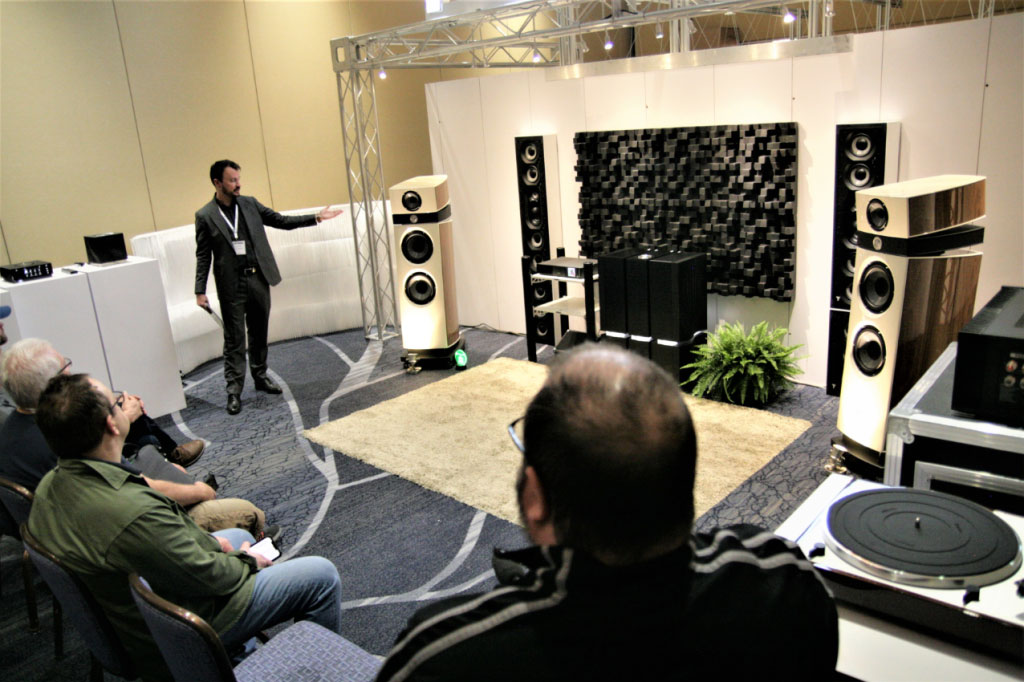
SCHAUMBURG, IL - Wildly popular among high fidelity audio enthusiasts, due to COVID related cancellations, the annual three day Audio Expo North America—or AXPONA—last showed here in 2019. And now on Day One, it's Friday noon and people have come out in droves. Frankly, I cannot find a parking space at the Renaissance Schaumburg Hotel and Convention Center where it's being held. I'm shocked.
"Doesn't anyone work on Fridays?" I think while circling the right and rear side lots for 10 minutes (as a full-time teacher, I'm on spring break this week).

Finally, I discover and slide into an open slot, but the rear end a large camper van with Arkansas plates is protruding three feet into my space, forcing my Toyota Corolla to stick out a yard into the aisle. I think about leaving it there, but the fear of a costly parking ticket triggers another search before I surrender and exit, parking in a lot across Thoreau Drive .
I stride into the hotel's first floor lobby and spot Qobuz Vice President of Business Development, David Solomon dusting off their giant black banner (Qobuz is a popular, high res music streaming service preferred by many, including me, that's supplying music to over 140 listening rooms here). Sporting a chic, short salt and pepper business haircut, mustache, glasses and goatee, he's fit and spry in his pressed gray shirt and black slacks. Looks like all that kayaking with his wife, Kristi, is paying off in spades.
I call out to him. Turning around, a large, winsome grin stretches the span of his face.
"How are you doing?" he asks, shaking my hand. "Have you heard the rooms here? There's some great ones—and some bad ones, too!"
I can't help but think afterwards that he's a marketing marvel, the perfect cross between a Wall Street rock star and a televangelist. But, nevertheless, he has a point: Indeed, there are some great sounding rooms here.
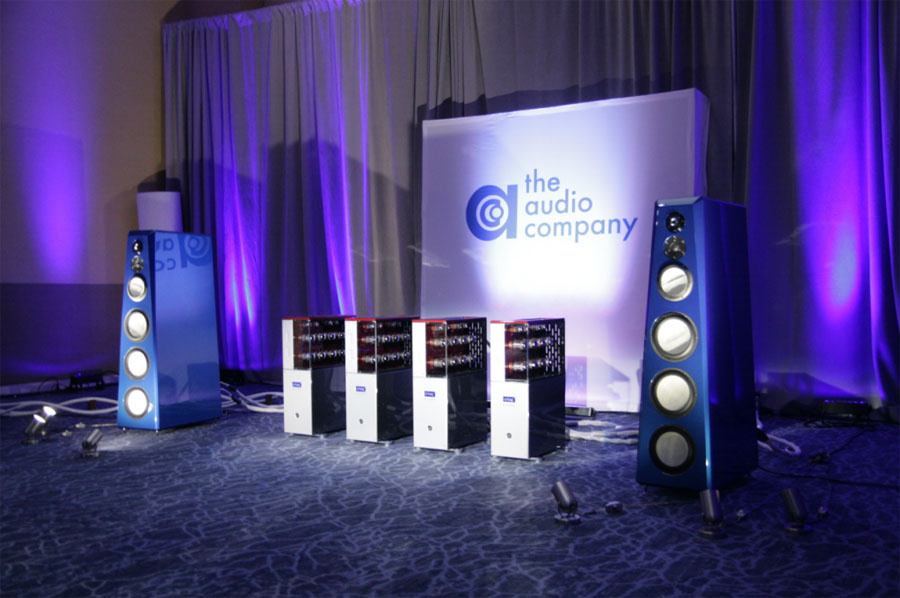
Von-Derful Von Schweikerts
Premiering first at the Florida Audio Expo 2022 in Tampa, Florida back in February, the new Von Schweikert ULTRA 7 loudspeakers ($180,000/pair) boast what appears to be two pairs of sinuous white Burmese Pythons stowaways emerging from the back of their magnificent cabinets and connecting them to four large VAC amplifiers in between them.
They're a commanding presence, bellowing regal and triumphant in the Utopia Room B to a spellbound crowd seated in rows of banquet chairs. Not nearly as tall as their ginormous flagship ULTRA 11s from AXPONA 2019, standing maybe 6 feet, they're plenty big in their own right, effortlessly pressurizing this 59'D x 30'W x 15'H room. Bipolar in configuration, they boast the following drivers:
- Front Firing – three 9" reinforced Ceramic Woofers, one 7" reinforced ceramic midrange, one Beryllium tweeter and one dual ribbon super tweeter.
- Rear Firing – one ribbon super tweeter and one Magnesium horn loaded tweeter combined into their rear ambient array.
As such, their ULTRA 7 design claims a full-range response from 18Hz to 60kHz with 94dB sensitivity at 1 watt/1 meter.
During my listening, violins are clean, crisp and bigger than life; plucked acoustic guitar strings are vivid and detailed, their woody hollow bodies resonant echo palpable.
Next, in Peter Gabriel's "Mercy Street," the emotive power of his raw, raspy vocals breaking apart into harmonic distortions are vivid, visceral and up close, while the triangle and other percussion instruments dance and shimmer about the air. It's magnificent.
Glancing up, I spy rows of pillows stuffed in the space between the thick soffit and the surface of the recessed tray ceiling it surrounds.
I turn to Damon Schweikert, Chief Executive Officer of Von Schweikert, and ask if they're placed there to address bass issues.
Trim and well coiffed with a neatly combed beard, necktie and blue suit, he says that the pillows, in fact, were used to "deaden the high frequency zinging with a decay of several seconds...created by the cavity between the soffit and the air duct passageway."
There are other acoustic issues presented in the room, he adds; the placement of tall tube bass traps addresses bass nodes, and curtains surrounding the banquet hall helps dampen reflections but only tame a portion of the upper frequencies, while offensive lower ones remain somewhat problematic. As such, the presentation is rich and pleasing, however, I don't hear the soundstage extending beyond the walls that broader spectral absorption might affect.
"I was going to install an acoustic cloud [i.e., absorption material suspended above with an air gap to dampen ceiling reflections], but the workers said that it'd be too difficult," he says. "But it wouldn't be too hard, really! Maybe we'll do that next year."
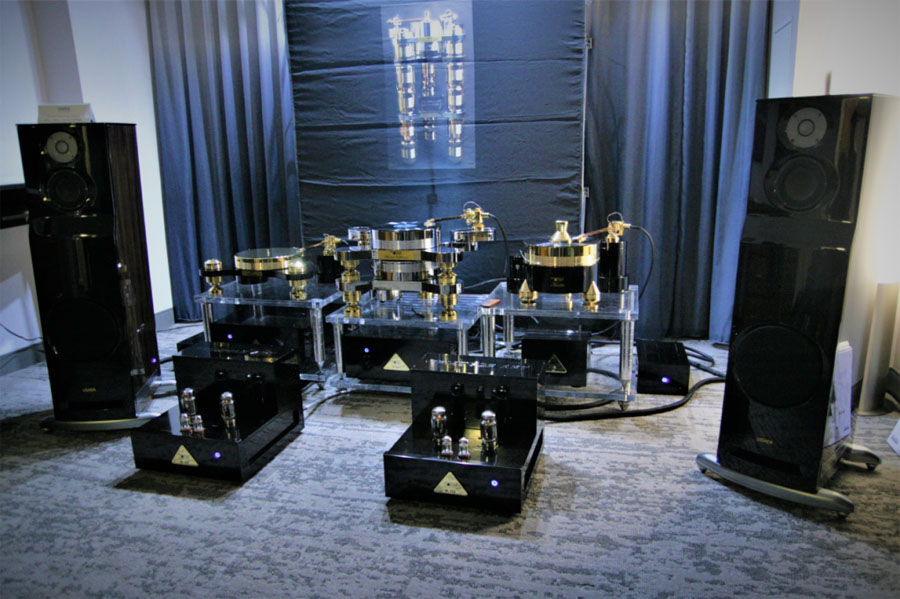
Triumphant Triangle Art
Based out of Anaheim, California, Triangle Art manufactures massive and sculpturesque metal alloy turntables, amplification and—now—horn loudspeakers, and in Room 614, they're showcasing some of their finest.
Playing over vinyl on the gleaming, dual plinthed, machined black and gold Triangle Art Master Reference turntable ($39,990) with the Osiris Diamond 12" tonearm ($8000), the timbre of Andrea Bocelli's vocals are natural and rich, while the orchestra's strings, woodwinds and the piano are clearly articulated in this rich and refined presentation.
The sound emanates from an imposing pair of Usher Audio ML-801 loudspeakers ($14,750) in high gloss Macassar Ebony. Inches shy of four feet tall, their three way, three driver design features a magnesium alloy tweeter and midrange driver, accompanied by an eight inch hybrid carbon fiber woofer, and it delivers the signal with great clarity and depth.
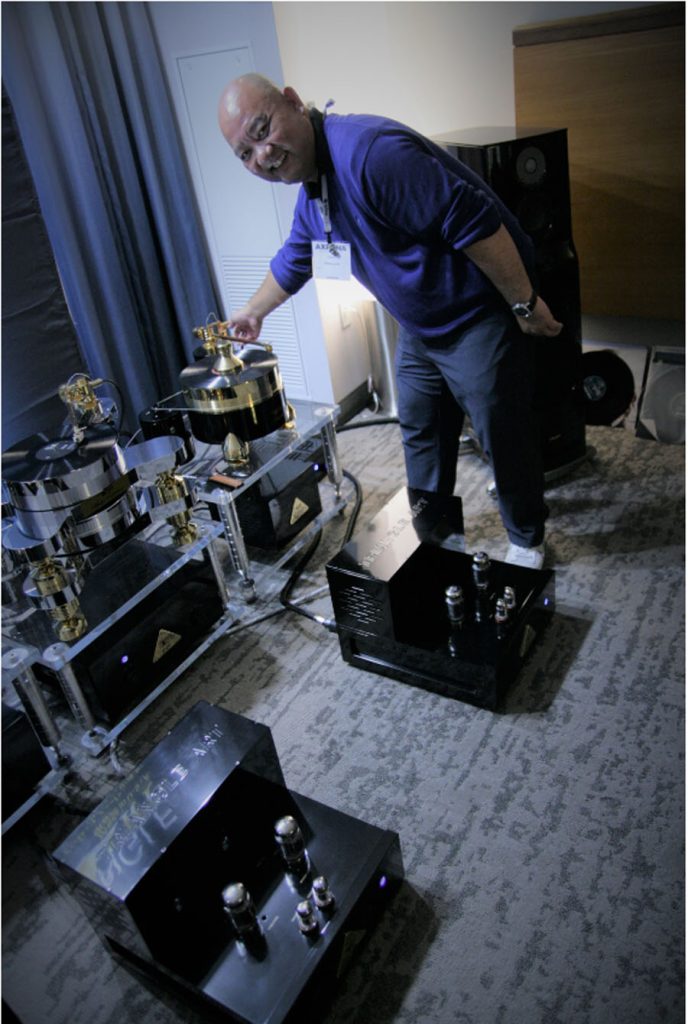
Triangle Art CEO, Tom Vu, who's running the room in a blue long sleeved sports shirt, jeans and shaved head, lifts the record clamp off the Master Reference table and places it atop another plattered record on the nearby Triangle Art Anubis turntable ($15,500) with their Horace tonearm, another reference turntable of three on display.
He hits play and, moments later, Ella Fitzgerald's mezzo soprano vocals shine in their tonal purity, while Armstrong's grit and gravely baritone enchants in Louis Armstrong's "Can't We Be Friends."
Supporting playback are the Triangle Art P200 Tube Phonostage ($15,000), Triangle Art L200 Tube Linestage ($20,000), Triangle Art M100 Tube Monoblock ($25,000), RA Ultimate AC Power Filter ($11,000), Triangle Art RHEA Reference Interconnect ($2800), RHEA Reference Power Cord ($2800), and RHEA Reference Speaker Cable ($4990).
I drop by for a second listen on day two and on am captivated by David Brubeck's "It's a Raggy Waltz," where the ringing, shimmery sound of the ride cymbal, the fleshed out fullness and slam of floor toms, and the resonant drum skins and their cabinets are palpable and stunning via the Osiris turntable.
If there's one thing I can nitpick—and it's not just with this display—it's the impact of the small guest rooms at the hotel; save for the window's curtains and the Triangle Art banner, at roughly 250 square feet sans acoustic treatment, the close confines and bare walls impart a slight edge to the already detailed image of these towers. The addition of warm bodies helps, but to reduce the room's effects, greater speaker toe-in is required, but then the Magnesium alloy tweeter and midrange drivers are pointed directly at the listeners' ears, whereas angling them out further would be more ideal, in my opinion.

As a side note, after the show, I took the Usher ML-801s home for review, and set up in my listening room, there was no hint of harshness, and Belle and I spent three spellbound evenings the following week listening—and dancing—to their evocative presentation.
That shouldn't surprise, as the same thing happened with a magnificent pair of large horn speakers featured at AXPONA about five years ago; a bit bright sounding in its tiny hotel room, when transplanted to our more spacious, acoustically treated family room, the results were spectacular.
When I mention that I wish the room was larger, Vu says, "Yeah," with a shrug. "There's only so much you can do."
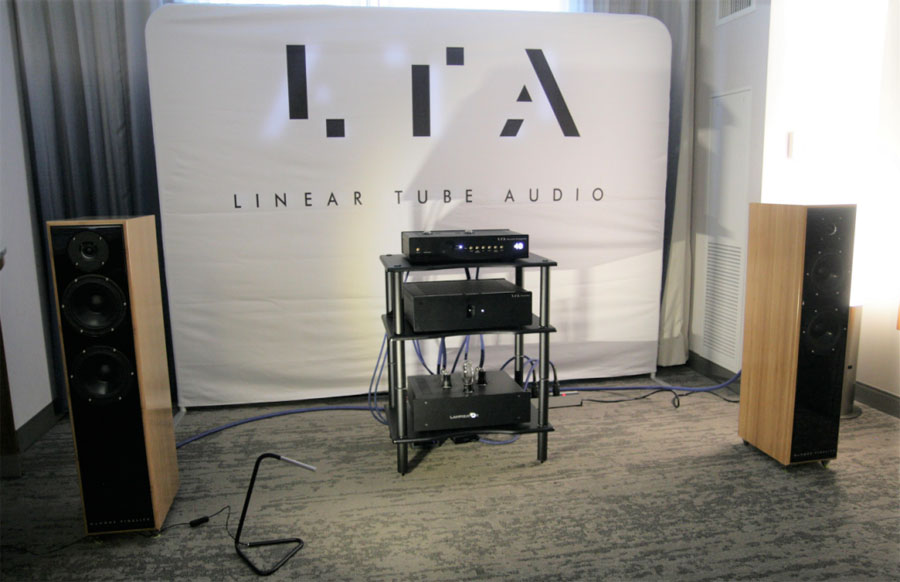
Color me Impressed with LTA
The old adage, "good things come in small packages," really applies to the Linear Tube Audio (LTA) room. Starting off, an Intel NUC running Roon Core (maybe $650), fed a Sonore Ultrarendu ($999) and linked up to the Lampizator Baltic 3 DAC ($6600) via USB cable—which, in turn, fed the music signal to the Linear Tube Audio (LTA) Microzotl Level 2 Preamplifier ($5750) and ZOTL Ultralinear+ Power Amplifier ($6800). The result? They produced a very rich, nuanced and surprisingly room filling presentation from the petite, 37" tall Fidelity Gibbon Super Nine Loudspeakers ($9900/pair).
"It's all about system synergy," Nicholas Tolson, Sales and Marketing at LTA, says. "We brought our amps up to DeVore Fidelity in Brooklyn earlier this year. After hearing the LTA Ultralinear+ with the DeVore Super Nines, we all agreed the combination was something special. We use a LampizatOr Baltic 3 every day at LTA, so we knew that would fit in nicely. We're very happy the system got such a positive response and that AXPONA attendees enjoyed the system as much as we did."
James Taylor's warm and soothing baritone is lush and big in "Roll All Over You," and in a recording by acoustic guitarist, Marcin Kashmir, the strums and tone emanating from his hollow bodied instrument are vivid and three dimensional, while the accompanying bass is sonorous and palpable.
Sandra Jarosz's breathy vocals on "Simple Twist of Fate" are smoky and evocative, the double bass' plucked strings delineated well, with a clear sense of the woody cavity behind them, and the sense of the recording room's air is very well articulated, imparting the very best of tube sound in this very impressive, organic and intimate performance.
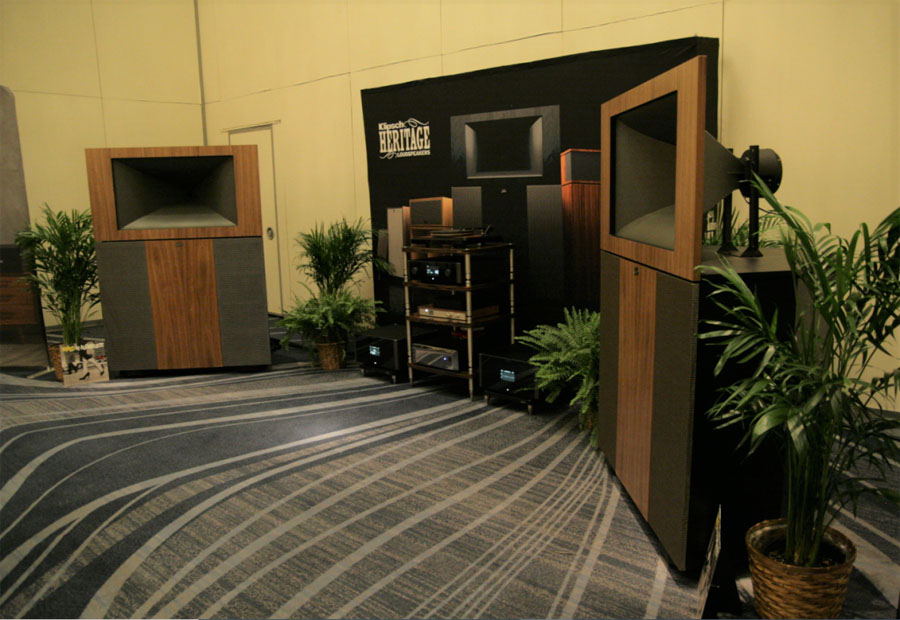
Fee, Fi, Fo, Hummm
On the other end of the spectrum, standing 69" tall, 50" wide, and 30" deep, the ginormous Klipsch Jubilee horn loudspeakers ($35,000/pair, including their electronic crossover) harnessed horn loading and vented systems to deliver 18Hz to 20kHz of walloping, immersive sound, filling the 34'L x 34' W x 22' H Schaumburg B room with immersive waves of sound, wowing visitors.
The Jubilee employs an all-new large format compression driver with a five inch axiperiodic Titanium diaphragm, which provides an impressively wide bandwidth performance and eliminates the need for a mid-range driver, which is true to founder Paul Klipsch's intentions for the Klipsch Jubilee. It also uses "an external active DSP crossover network to adjust the phase and time delay of each acoustic component to eliminate acoustic phase cancellations and maximize output in the crossover region for truer-to-life sound. (hifiheaven.net)
As with many of these premier rooms, the system backing the Jubilees reads like a movie credits list and consists of the following: A Roon Nucleus music server ($1495), two Rotel Michi S5 Amplifiers bridged as monoblocks ($7499.99/each), a Michi P5 preamplifier with phonostage ($4299), Roon Nucleus ($1495), Fender x MoFi PrecisionDeck turntable with Mobile Fidelity MasterTracker phono cartridge ($3495), Niagara 5000 Low Z Noise Dissipation System ($5500), Audioquest Thunderbird ZERO speaker cables ($7600/ 15 ft pair), Audioquest FireBird BASS speaker cables ($21,400/15 ft. pair), Audioquest ThunderBird XLR cables ($3900/1 meter pair), Audioquest FireBird XLR cables ($6900/ 1 meter pair), Audioquest Diamond RJ/E Ethernet cable ($999.95/.75 meter), Audioquest Diamond USB-A to B cable ($649/.75 meter), Audioquest Hurricane High-Current AC power cable ($1750/meter), Audioquest FireBird Source AC cables ($3000 each/meter), Audioquest FireBird High-Current AC power cables ($3500/meter each), Audioquest Mistral bulk power cable ($120/meter).
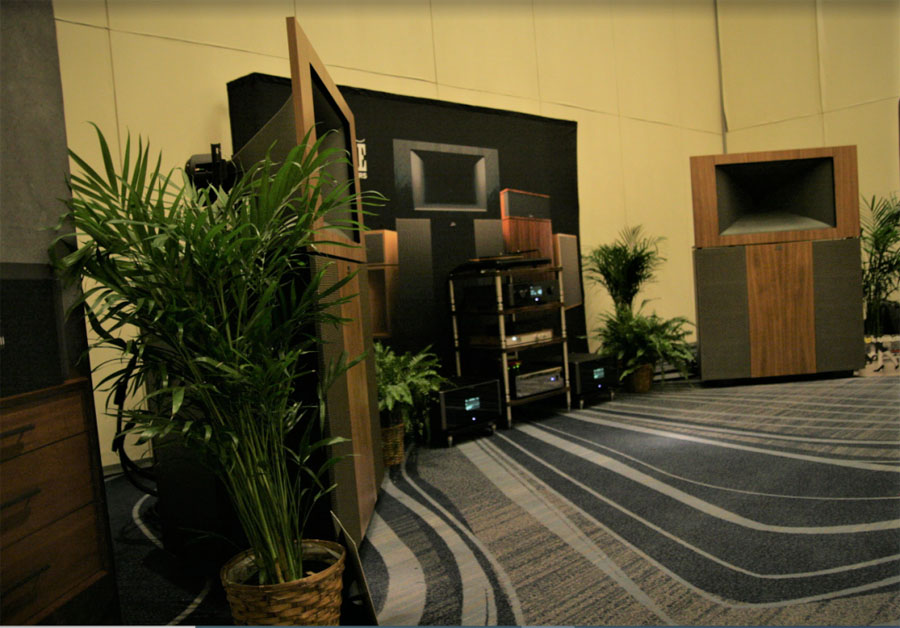
John Mayer's warbly baritone, guitar, drums and bass in "Gravity" came through clear, full, and approaching concert hall scale, while in an orchestral piece, the woodwinds, brass, and tympany were forceful and visceral in their attack. In "Sittin' on the Dock of the Bay," Simon Lynge's falsetto and whistling solo sounded natural and were delivered with great clarity, while the snare and drum kit packed plenty of punch and snap.
On the downside, there are criticisms that the room was a little too boomy (especially at the room's rear near its entrance), that it lacked proper speaker placement and acoustic treatment. One insider suggests that this may be attributed to the room set up being relegated to A/V employees from a swank, high end Northshore megastore, as opposed to audiophile industry veterans. Moreover, many of the song selections included sibilant pop files rather than higher quality recordings that would play to their strengths.
Nevertheless, despite these shortcomings, I found the Jubilees both delightful and formidable performers, a great fit for a well bankrolled music enthusiast with a large, properly treated listening space, and was very impressed with a subsequent interview I had with Klipsch's Principal Engineer, Roy Delgado, who was at Schaumburg Room B where they held court (I will feature our discussion in an upcoming article).
Nordost Stenheim Speakers
The Schaumburg F Room, where the $153,000 Stenheim Reference Ultime Two loudspeakers reside, has the same room dimensions as the Jubilee display—and for good reason: Sporting massive, aluminum cabinets just under five and a half feet tall with six independent chambers, two 12" woofers, two 6 1/2" midrange drivers, and a 25 mm tweeter each in d'Appolito array.
The supporting cast includes: VTL TP-6.5 Series II Signature Phono Stage ($12,500), TL-7.5 Reference Line Preamplifier Series III ($30,000), and S-400 Reference Stereo Amplifier Series II ($37,500); WADAX Atlantis Reference DAC ($145,000), Atlantis Reference Server ($59,000), Aksas Optical system for Reference DAC/Server ($17,495); VPI HW-40 turntable ($20,000); Nordost Odin 2 Power Cord ($20,499.99), Odin 2 Analog Interconnect ($24,599.99), Odin 2 Tonearm Cable ($15,199.99), Odin 2 Speaker Cable ($35,999.99), Valhalla 2 Power Cord ($5999.99), Valhalla 2 Ethernet Cable ($3299.99), Frey 2 Power Cord ($1999.99), QBASE (QB8) AC Distributor Unit ($1749.99), QVIBE Line Harmonizer ($384.99), QKOIL AC Enhancer ($274.99), QPOINT Resonance Synchronizer ($824.99) QSOURCE Linear Power Supply ($2749.99), QSOURCE DC Cable ($299.99), QSOURCE DC Cable Premium ($399.99), QNET Network Switch ($3199.99), QKORE6 Ground Unit ($5499.99), QCORE Wire ($239.99), QKORE Wire Premium ($349.99), QBASE/QSOURCE Stand Mount ($124.99), Sort Kone AC ($94.99), Sort Kone BC ($169.99), Sort Kone TC ($424.99) and Sort Lift ($649.99).
The Rem Peplowski Quartet's "Memories of You" delivers a delightfully lucid and natural sounding clarinet and tenor saxophone, while Richard Strauss' "Also sprach Zarathustra" (the theme song from the movie, 2001 a Space Odyssey) with the brass section kicking kettledrums, and the orchestra is vivid, visceral and resplendent in its delivery.
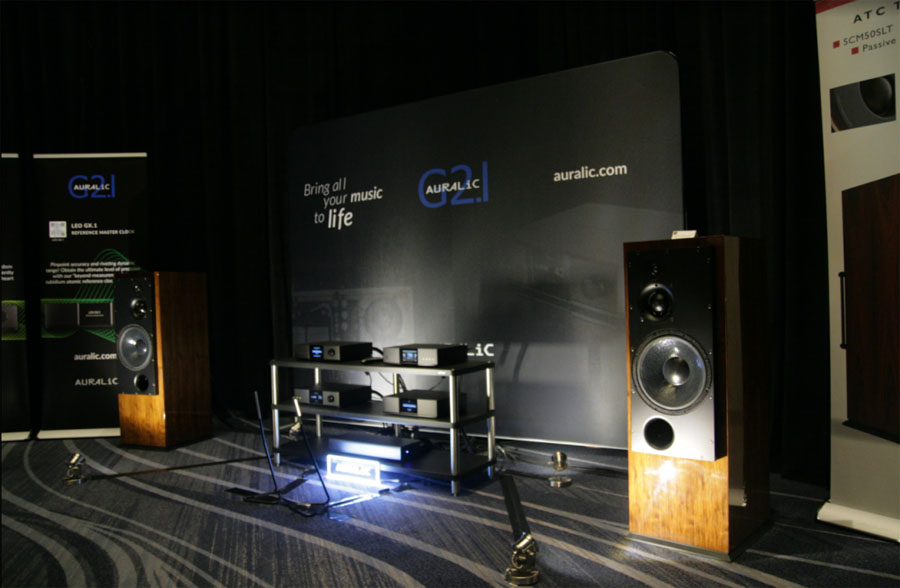
Au Magnifique AURALiC
In yet another 34' x 34' x 22' conference room, the AURALiC G2.1 Wireless Streamer Transporter ($5499) paired up with the ATC SCM 100 ASLT Active Tower speakers ($19,990/pair) turns heads. King Hannah's "A Well Made Woman" is vivid, large and lifelike with studio monitor precision. From the impactful toms, the thwacking, crisp snare, the jagged edged electric guitar, and throaty, guttural female vocals, it's compelling and very impressive.
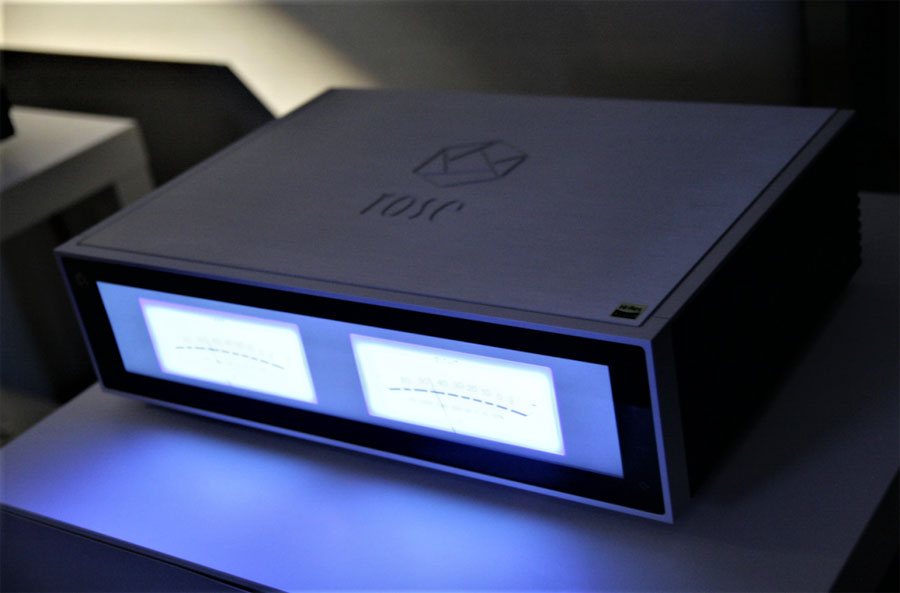
A Rose by Any Name
The Hifi Rose RS 150B Streaming DAC ($4995) is a gorgeous and flexible DAC, digital streamer and preamplifier with an impressive customizable 14.9" wide HD IPS Touch Screen LCD display with viewing selections that includes captivating VU meters. Amongst other things, it supports Qobuz, Tidal, internet radio, Spotify, Airplay, and YouTube 4K (it filters out commercials), the sales person tells me.
Its inputs include: AES/EBU, HDMI ARC, USB, Toslink, Coaxial via RCA, and I2S, as well as XLR balanced and RCA unbalanced. It supports PCM up to 768kHz, 32-bit, and DSD up to DSD 512.
My friend, Joe, is smitten with the VU display and its impressive feature set so much that he's kicking around the numbers as we exit the room.

Marvelous Mangers
Hailing from Germany, the Manger P2 loudspeakers ($18,995) were an aural treat. At the core of their magic is their full range transducer. Scarcely larger or thicker than an appetizer plate with a star pattern on its face (the emcee holds one in the photo above), it seamlessly covers the 80Hz to 40kHz range, while the lower end is covered by a woofer inches below and two passive woofers on the backside.
There's a Dr. Feikert Analog Blackbird turntable ($7495) up front, and served by the Hifi Rose RS250 streamer ($2495) and driven by a Mastersound Compact 845 Integrated amplifier ($10,495), utilizing an Isotek Aquarius 6 Outlet power conditioner ($2000), it delivers a fast and engaging presentation.
On the Stimulators' "St. James Infirmary," gravelly blues vocals and the muted trumpet, as well as the electric guitar, are warm, vivid and lifelike. And in another recording, the tone and texture of Edgar Meyer's bowed double bass is rich, taut and resonant, the mandolin and banjo very clear and palpable in the room.
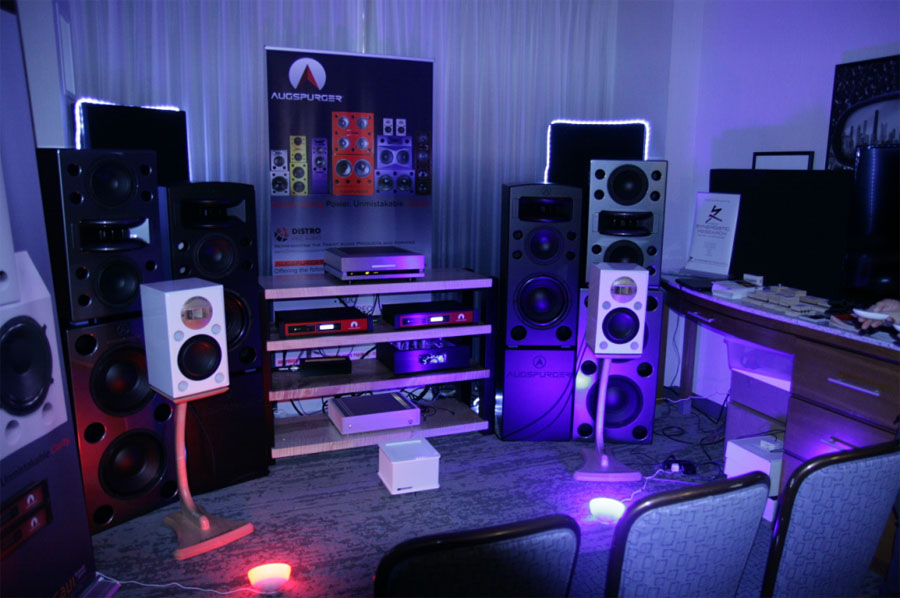
Pro Audio Presents Precise and Breathtaking Monitors
They're smallish white, boxy and utilitarian, with a wood finished duck-billed horn waveguide up top, a black bass driver below, two bass ports at either side of the mid section and two on the bottom front sides. Perched atop curved stand mounts, the larger subwoofers behind them have other unused monitors seated on top of them.
The Augspurger SXE 3D 3-Way DSP Networked amplifier ($4995) is driving the Augspurger MX65 Monitors ($10,995) and the Augspurger Sub 212 ($4250): 2000 watts feed into the sub channel, 600 to 800 watts in the mid channel, and 400 watts into the high horns.
The Monitors are the progeny of Pro Audio Design, who've provided megahit pop artists like JayZ, Alicia Keys, WuTang, Snoop Dogg, Dr. Dre, Nelly, and other leading artists with their speakers to help craft their recordings. As such, they are surprisingly rich, full bodied and image surprisingly large. You can hear the grain in Leonard Kohen's sonorous bass vocals singing "Thousand Kisses," for example, which envelop the entire hotel room.
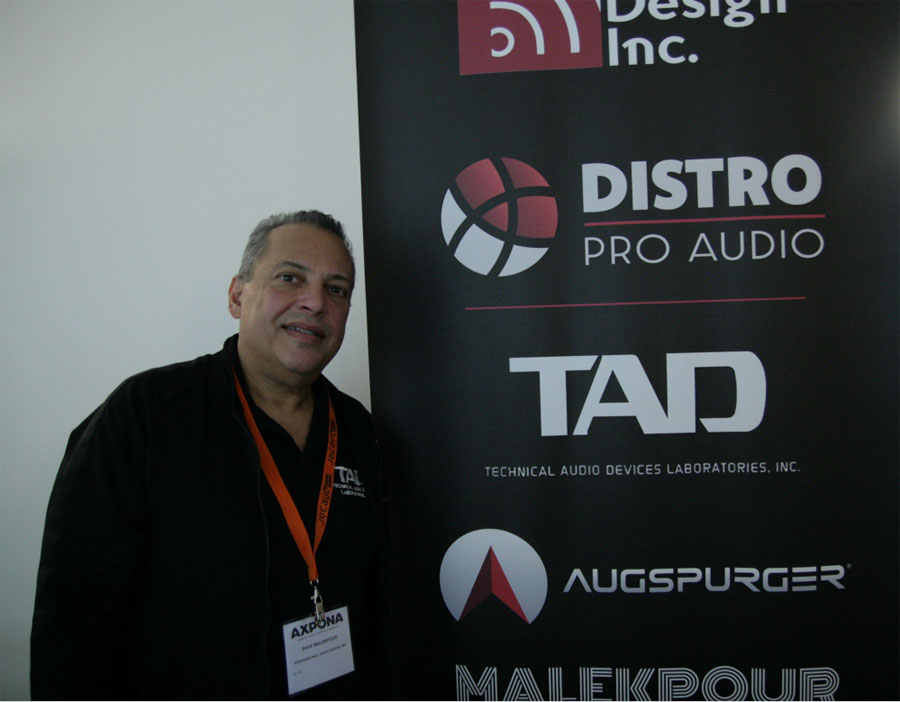
I interviewed Dave Malekpour, President and CEO of Professional Audio designs after the listening session, the contents of which will appear in a future article.
In Yo Face with Innuous
Curious to hear the Innuos Zen Mini Mark III Music Server ($1399), I visited the Innuos Room. Lined up with various Innuos music servers, including the Zen Mk3 ($2849), they are linked to the Benchmark DAC 3B ($1699), PS Audio Stellar Gain Cell DAC/Preamplifier ($1699), and the PhoenixNet Network Switch and Reclocker ($3499). A selector switch is used to compare their performances using a Meze Elite pair of headphones ($4000). Clicking on several song selections capped off with Patricia Barber, I find the Zen Mini Mk3's presentation transparent and balanced throughout the sonic spectrum. Ironically, though, as I click up their model level, I fail to notice much difference. They're all good!
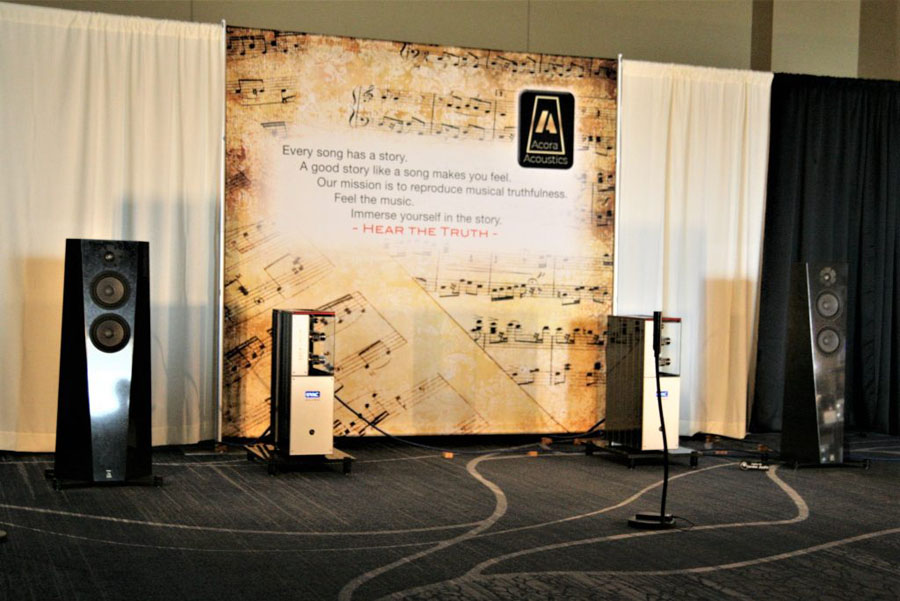
Acora Acoustics is Aces
Tucked out of the way on the front end of the Convention Center in the Nirvana A Ballroom, they'd be easy to miss but, oh so unfortunate if you did.
Based out of Scarborough, ON Canada, Acora Acoustics has come up with a winner in their SRC-2 Loudspeakers ($37,000/pair). They feature 1 1/4" thick granite cabinets, which are heavy and inert at roughly 246 lbs. each, providing "the unique chance to get 99.9 percent of the energy out of your speakers," Valerio Cora, owner and CEO of Acora Acoustics claims. "It's hard to believe that two speakers with two six-inch drivers and a tweeter can fill a 59' x 15' x 30' room like this!"
No doubt, the Acora Acoustics SRC-2s deliver with surprising power and clarity for their size, filling this ballroom (which like others, has pillows stuffed in between the soffit and ceiling overhead) with an oversized image that's both immersive and mesmerizing.
"Everybody says, 'Where's the subwoofer?'," says Greg Beron of United Home Audio.
The interaction and synergy between sources, players, supporting electronics, loudspeakers and room yield the most pure and sublime results I've heard and, to my ears, are the best in the show.
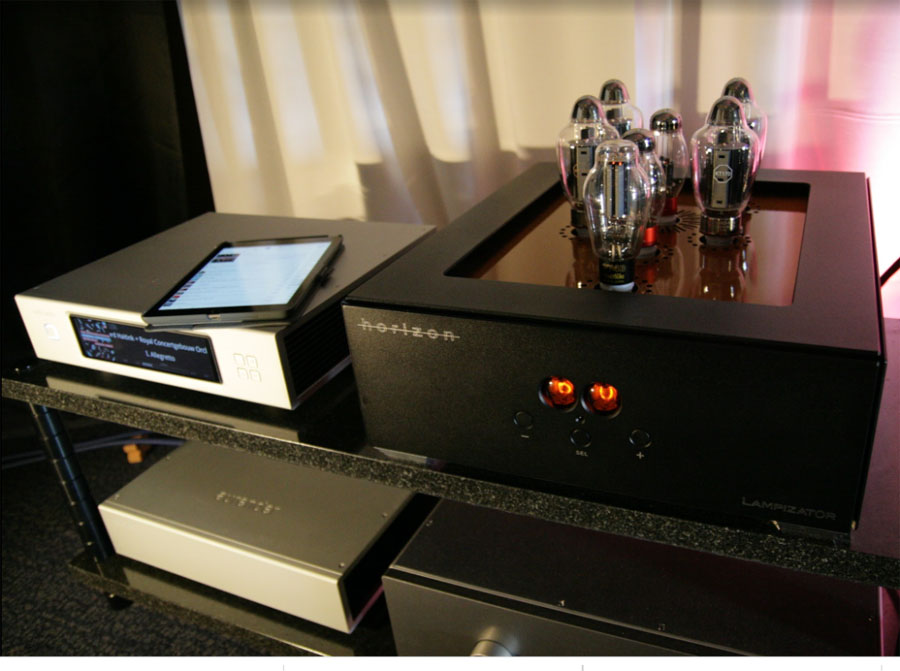
Playback rotates from the Aurender N30SA music server ($24,000) in tandem with the LampizatOr Horizon DAC ($49,000), the United Home Audio Superdeck open reel to reel tape player, and the TW-Acustic Black Night turntable ($45,000) with the TW-Acustic Raven 12" tonearm ($6000) and VAC Statement Phono preamplifier ($80,000). The VAC Statement Line preamplifier ($80,000) and VAC Statement 452 ($150,000) deliver the sound.
Served up digitally, Eva Cassidy's vocals in "Fields of Gold" are highly resolved and natural, the swell and decay of her lovely notes accompanied by the acoustic guitar transfixing; the electric guitar's lead is pure in tone, while the rhythm guitar is crisp and natural.
Buddy Guy's strong, chesty vocals are clearly articulated, the angst and whaling of his electric guitar vivid, Tracy Chapman's voice rich and genuine, and the stick strikes on snare impactful and true in "Ain't No Sunshine" on 33 1/3 vinyl. Delivered with lucid clarity, it's an enchanting listen.
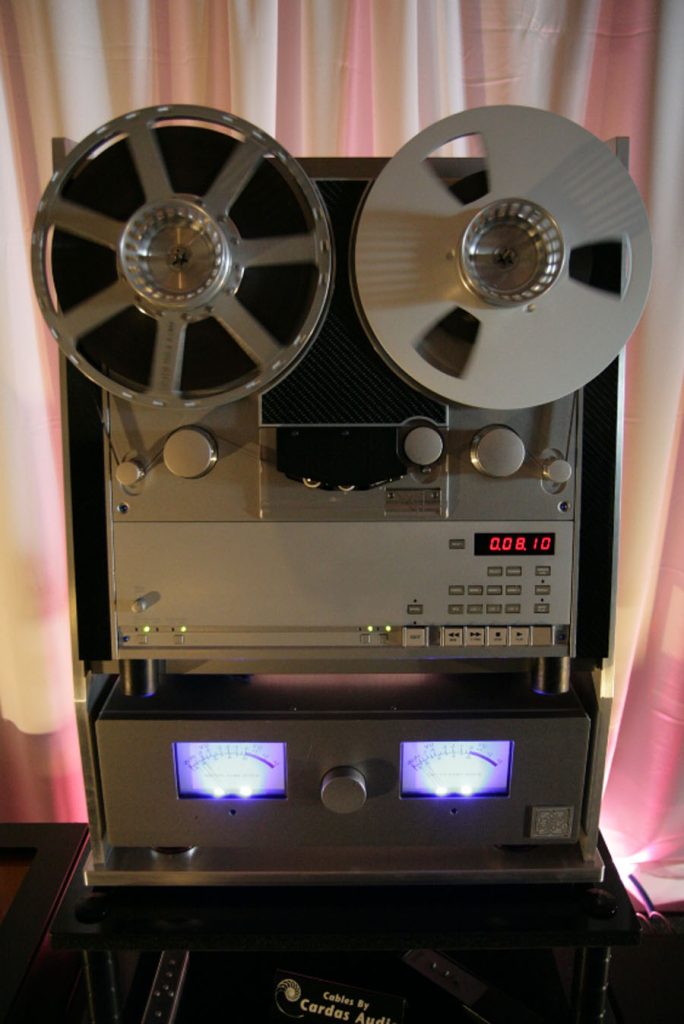
Beron puts on his copy of a master tape of Lou Reed's "Walk on the Wild Side" on the United Home Superdeck reel to reel, and we are transported back to the August 1972 recording session. Reed's nasal vocals are eerily natural and clean, Herbie Flowers' walking bass line full and luminescent. The violins rising from in the backdrop are more apparent that I recall, and background singers Karen Friedman, Dari Lalou, and Casey Synge's "Doo, doo-doo" hooks shine are vibrant and vivid, while Ronnie Ross' sonorous sax solo is a living, bellowing beast. What an amazing treat!
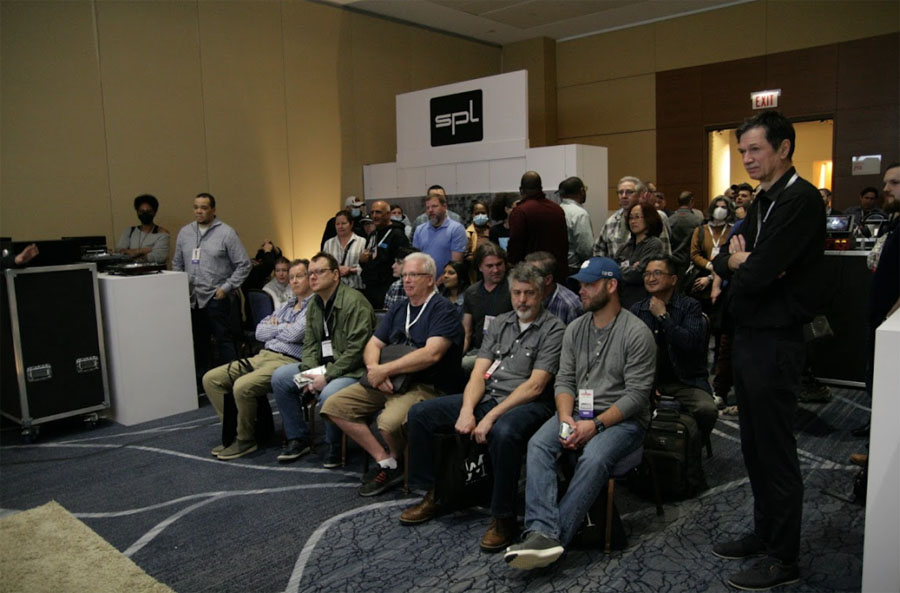
Focal Utopia Delights Crowd with High End Club Sound
A large pair of Focal Maestro Utopia Speakers ($37,999 each), amplified by Naim Statement components totaling $389,997 and sourced by a Naim NDX2 ($8799) delighted a Sunday crowd with its massive sound, while the in-wall 1000 IWLCR Utopia ($7599 each) surprised with both its finesse and power. Employed also were their 1000 IWSUB Utopia subwoofers ($2899 each), which employ a three driver module that's "equivalent to a 10" woofer," the emcee says.
Using their in-walls, Sohn's vocals in "The Wheel" were clear and present, the bass line very deep and immersive, while the drumsticks thumping the snare rim were crisp and palpable.
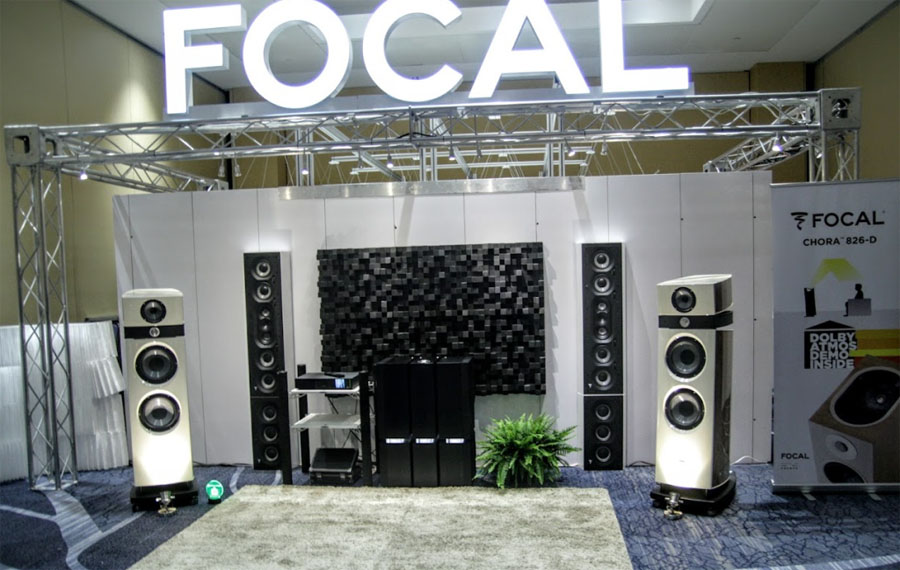
Switching over to the Maestro speakers, Elton John and Dua Lipa's vocals on "Cold Heart" are very defined, rife with effects, in this throbbing bass dance mix.
Vini Vici's "Make Us Stronger" is ambient, but turns loud and thumping, enveloping the room with powerful, room shaking slam and subsonic thud, evoking an elite, multimillion dollar club sound packed with startling clarity. The processed vocals are sharp and reverb drenched. Like the climax of a Fourth of July fireworks show, the cascading pulsating show evokes enthusiastic applause from the crowd.
Focal Chora Packs Immersive A/V Atmosphere

In the room to the back of the Focal Naim exhibit, a Chora full Dolby Atmos with a flat screen TV and couch setup delivered the goods. This faux family room setup included a series of Chora loudspeakers, with a pair of Focal Chora 826D speakers ($2398/pair) holding court upfront, linked up to each channel and two subwoofers. A Focal Astra 16 processor amplifier. The whole shebang was controlled by a Focal Astra 16, 16 channel A/V processor-amplifier ($14,999). Pop video music served up via Apple TV result was impressive—full bodied and immersive.
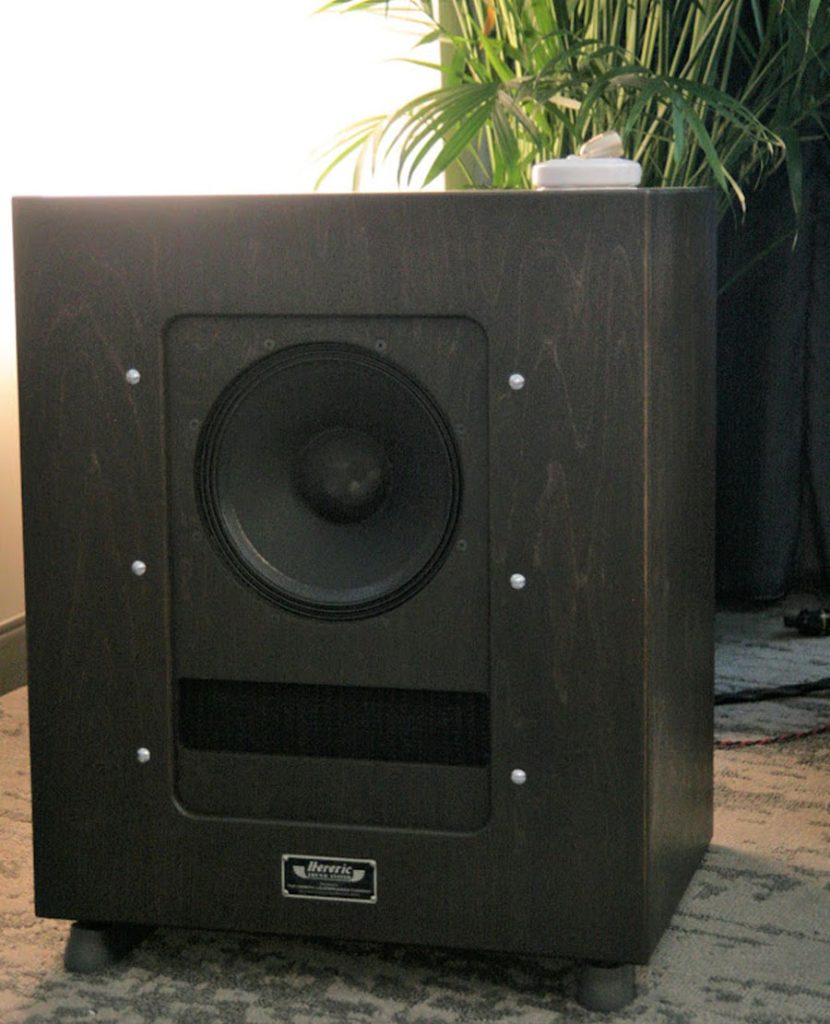
The Healing Heretics
Holding court in the Fidelis Distribution room, a pair of Heretic A612 High Sensitivity Loudspeakers (price to be announced later) soothe these bleeding ears with their warm and intimate sound. Employing a CD player, the Beatles "Getting Better" renders a vintage tube sound, with a warm and solid double bass, clean vocals and an overall musical, not hyperdetailed, presentation.
The supporting cast included: the Lab 12 pre1 Class A Tube preamplifier ($2190), the Lab 12 Suara Class A 50WPC KT150 amplifier ($4490), Lab 12 Melto2 Remote Controlled Tube Phono Preamp ($4490), Lab 12 Integre4 Remote Controlled 65WPC KT150 Integrated amplifier ($4900), Lab 12 Mighty Class A 10WPC Power Amplifier, Lab 12 DAC1 Reference DAC ($3290), Lab 12 Gordian Power Distributor/Conditioner ($2,390), and Lab 12 Knack AC Main Power Cables 16 Amp/20 Amp ($490/$590). The Avid Hifi Valvere Turntable ($8000), TA-3 Tonearm ($850) and Grado Opus 3 Cartridge ($275) were also featured players in the rotation.
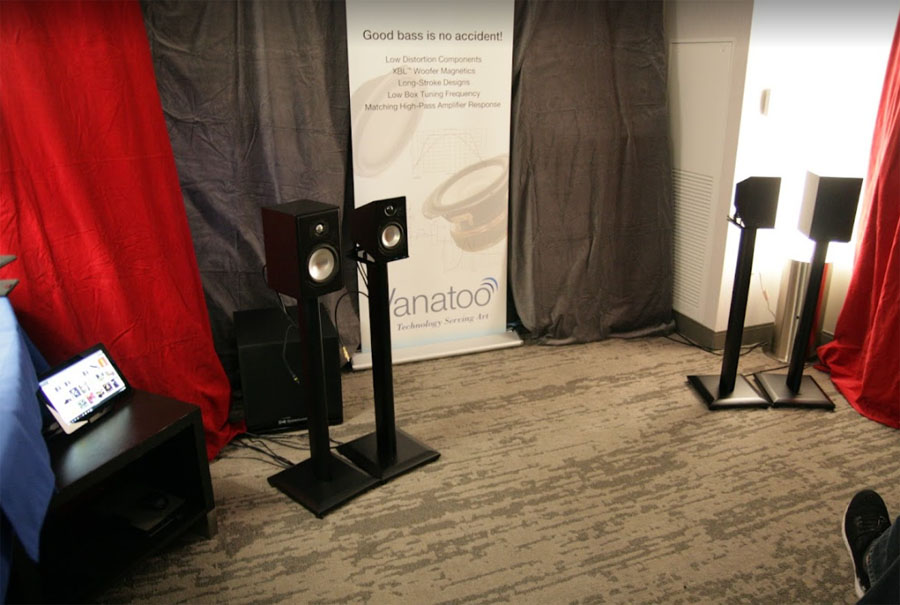
Vivacious Vanatoos
I run into Rich Sax, president of the Chicago Audio Society, and he insists that I give these tiny Vanatoo Transparent I Encore ($600/pair) a listen. Self contained, they render Adele's effects enhanced vocals and piano with richness and aplomb, filling the 12' x 15' hotel room with luscious sound.
Switching over to the smaller Transparent Zero speakers ($399/pair), Mark Knopfler's vocals are vibrant and clear. An Adele song that follows unpacks a vivid piano and bass that's shocking for such a tiny speaker sourced by a laptop computer. Good call, Rich!
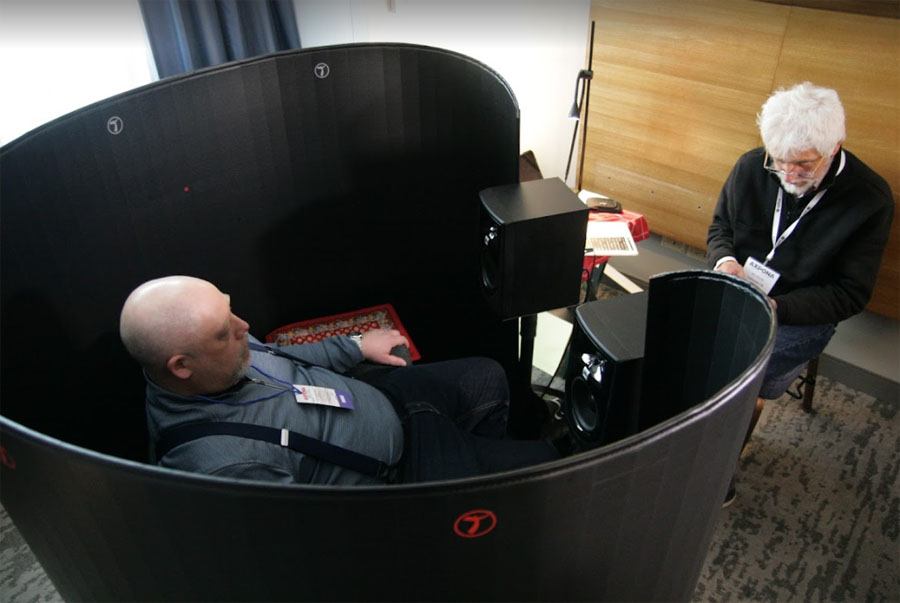
Hold That Tiger
Resembling an extra large, ribbed yoga mat stood on its side and curled up nearly 360 degrees, the Tiger Fox Immerse 360 ($479) encloses a single listener and reflects the sound provided by speakers in the narrow opening upfront. It doesn't look like much, but they provide a delightful, lively, wraparound audio experience. It's a tight squeeze getting in, but once you're in and seated, prepare for some fun!
Using the inexpensive powered JBL 3 Mk II ($149 each) on stands, they do a nice job of delivering the likes of Pink Floyd's "Time," with the ominous clocks ticking sound 360 degrees about me, and the alarm and gongs sounding out behind me.
The creaking door and steps in Michael Jackson's "Thriller" likewise appear to be playing behind my head.
In Charles Lloyd's "The Water is Wide," the double bass is deep, while the ride cymbal and saxophone are vivid and detailed. Overall, it's a sweet sounding apparatus with an engaging aural experience. This could be boon for gamers, apartment dwellers, or late night listeners who enjoy listening alone.
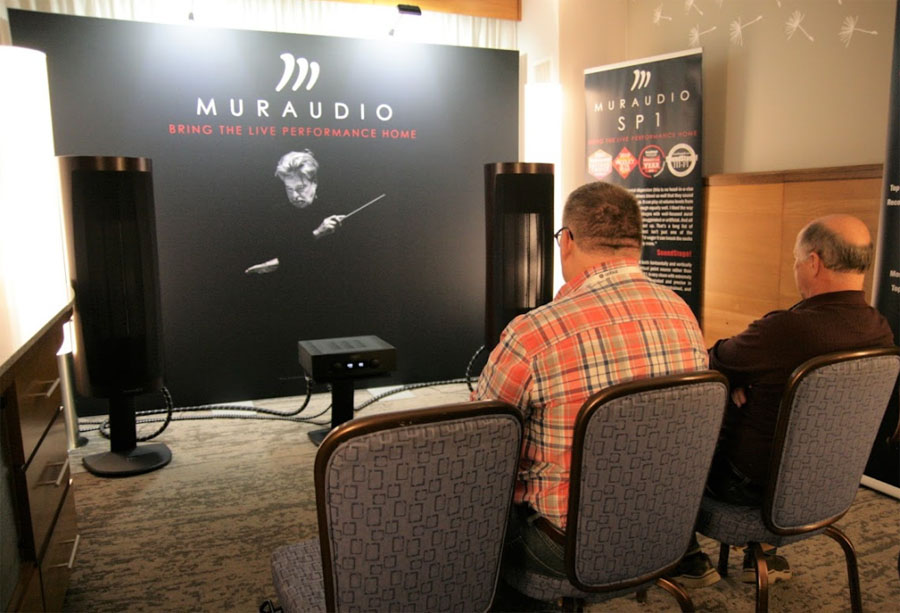
Marvelous Muraudio
Resembling tall, stand mount punching bags with screened, translucent center panels, the Muraudio SP1 ($19,500/pair) loudspeakers present a warm, pristine, ear tickling sound are reminiscent of some of the best electrostatic speakers I've heard—the Quad 57s.
"Those Who Wait" by Tommy Emmanuel features acoustic guitars that are lush and refined. It's a large soundstage, filling the space upfront.
In Louane's rendition of "Ta Peau" the vocals and effects are ethereal and airy. The bassline is deep and the chillout electronica mesmerizing.
Youn Sun Nah's "Momento Magico" delivers clear, sumptuous scatting over an upbeat, Samba beat. It's a delightful, modern spin on this genre, and you can hear the distinct sound vinyl strings on the hollow bodied guitar very well.
A Hegel H390 Integrated Amplifier ($6000) drives them to great effect.
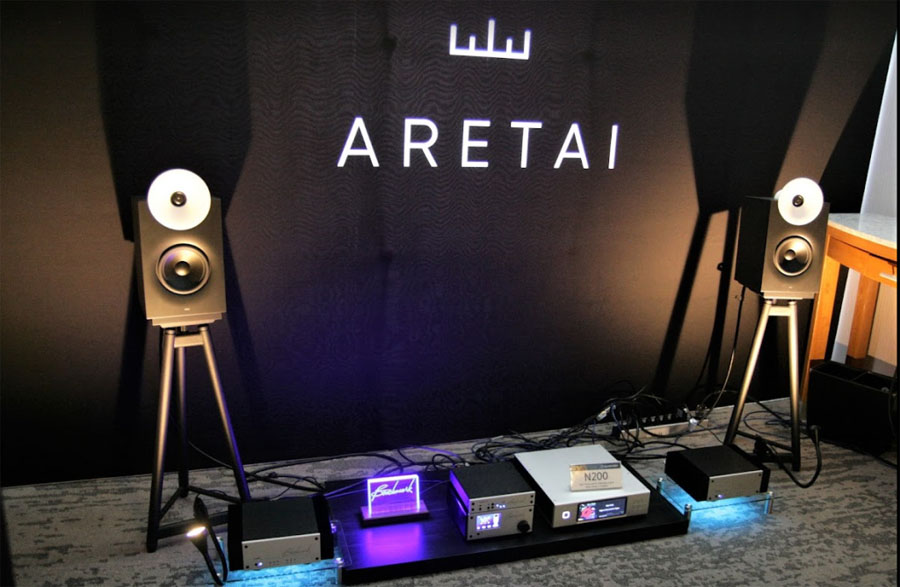
Arrivederci Aretai
The Aretai Contra 100S ($7,500) and Contra 350F Horn Loudspeakers ($46,500) cast a delightful spell with their intimacy; surprisingly full, they're an aural elixir of sorts. Parked on stands, they filled the hotel room with vivid renderings of everything thrown at them.
First up, the Contra 350 delights with its soundstage, which is delivered with unusual largesse for its small size.
Bella Fleck's "Flight of the Cosmic Hippos" tickled my senses with their rich delivery of the harmonica, banjo, bass and high hats.
London Grammar's "If You Wait" are evocative with their smoky, low female vocals. It's haunting and vivacious with the lilting guitar comps and the deep, subsonic bassline.
Yello's "The Race" put an involuntary smile on my face with its effervescent horns, guitar vibrato, keys, floor toms and catchy thumping tune.
Switching things up, the new Contra 100S takes over. It's a closed design, passive speaker with a second, rear firing bi-pole driver that's in phase. They incorporate special filtering to extend down to 30Hz, delivering a surprising big sound for such small speakers.
"Group Delay" is mitigated, founder and CEO, Janis Irbe explains. "You can't hear it, but it raises performance below 30Hz. That's why we have more bass relief. It's very dynamic and more precise; it's the avoidance of the audible group delay that is typical for small ported systems that makes bass character 'relief','" he clarifies. "I used this term as a noun describing precise character of the bass, not the feeling of the relief, though it can bring such feeling in some cases."
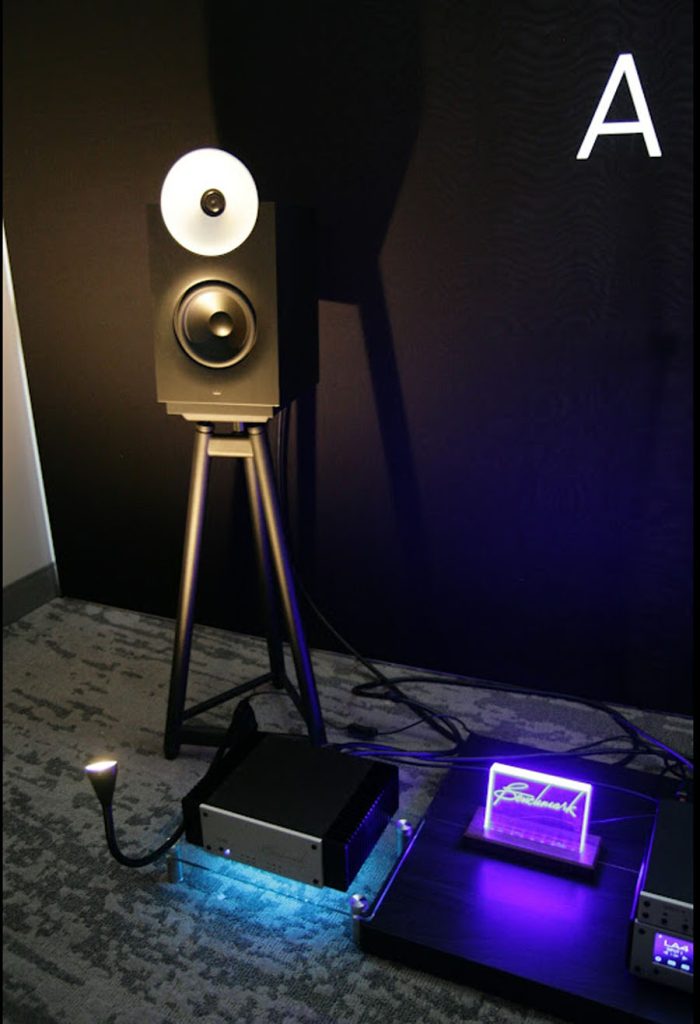
He continues: "Our bass is faster, more pronounced. Another thing we do differently is this waveguide," he says, pointing to the flattened horn assembly surrounding the tweeter. "It has a triple function: The tweeter works better and gains sensitivity in a linear mode, it bends high frequencies sideways; if you don't do this, the reflected spectrum won't follow the on axis spectrum." And lastly, he says, the shallowness of the horns makes it sound more lively and natural.
The Aurender N200 streamer ($6000) and the Benchmark AHB2 ($3000) in bridged, monoblock mode deliver the signal with aplomb.
"There are also natural scale renders of Contra 350 and Contra 200F Horn Loudspeakers ($50,000 and $25,000 respectively) that weren't available at the Axpona 2022 show, but that will be showcased at the High End Munich 2022," Irbe shares.
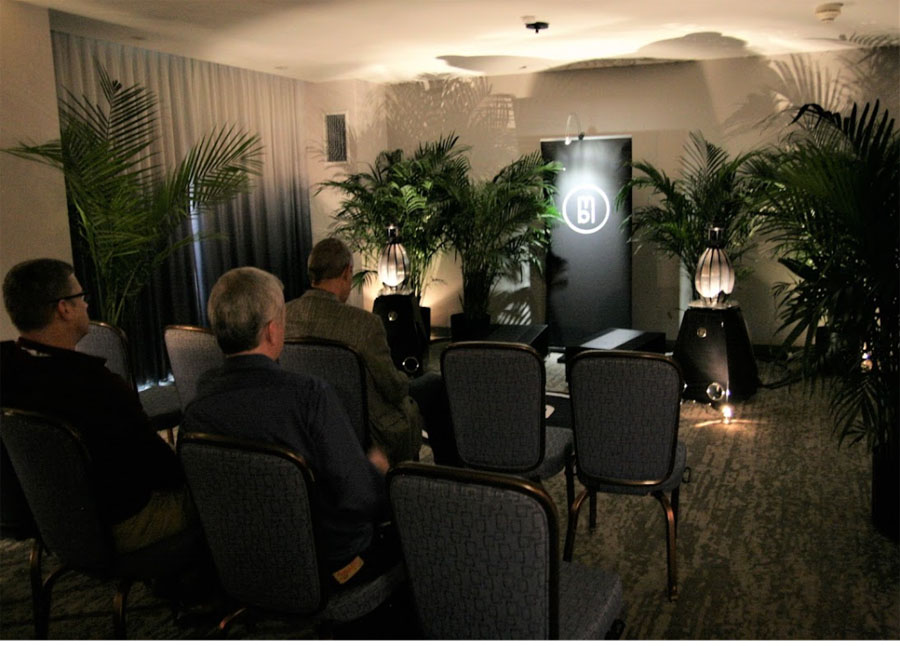
Those Memorable MBL 101s
A slender, 70-something is bobbing up and down, flailing his arms, dancing with wonton abandon at the rear of the room—and with good reason. A live rendition of Fleetwood Mac's "Tusk" with USC's Marching Band and its blaring brass section is playing at concert levels in maybe a 15' x 25' suite. It's brash, it's LOUD, and in your face. In a celebration of this amazing audio extravaganza, I can't think of a better way to wrap up my listening sessions than with the MBL 101 Mk II Loudspeakers ($84,500/pair).
At these volumes, it's a tad shouty, but it's also very crisp and thumping. The electric guitars versus the marching band's horn section, the guttural, tribal drums on steroids evoke a primal sense, transporting us back to our animal skinned ancestors dancing, chanting, and pounding on drums around a massive bonfire. It's visceral, it packs a huge punch, and moving.
The cost and particulars about the supporting electronics? Don't ask. My ears are bleeding now, and I need to go pronto. Wow!
A Little Personal Touch and Go
Several hours into Friday's show, my wife Belle texts that she left work early with a possible scratched cornea, is resting, and asks that I pick up eyewash and soothing eye drops on the drive home. After surveying a handful of exhibits, I leave to join her. Some things are more important than audio, after all.
The eyedrops help, so she doesn't need me to drive her to Urgent Care Saturday morning, instead opting for rest and a doctor's appointment on Monday, allowing me to return to the show. And after checking in with her at noon, she urges me to stay longer while she naps (subsequently on Monday, an ophthalmologist removes several lodged particles).
Shortly after arriving Saturday morning, I meet with friend, Joe Jurzek. The managing partner with an LLC specializing in computer maintenance management systems, he's also a veteran in the audio industry with experience reselling (i.e., Jam'n Audio and Purity Audio Design for example), setting up systems at shows, and bringing electronics designs to market. We take in the impressive Klipsch Jubilee exhibit where we are joined by Wes, a husband, father, sometime writer and full-time mortgage trainer who skateboards and loves audio. During our protracted listening session with the Jubilees, Wes tells me that his former home had a dedicated listening room with room treatments galore, but at his new home, like mine, it's more normal and serves as their multipurpose family room, yet still manages to sound very good.
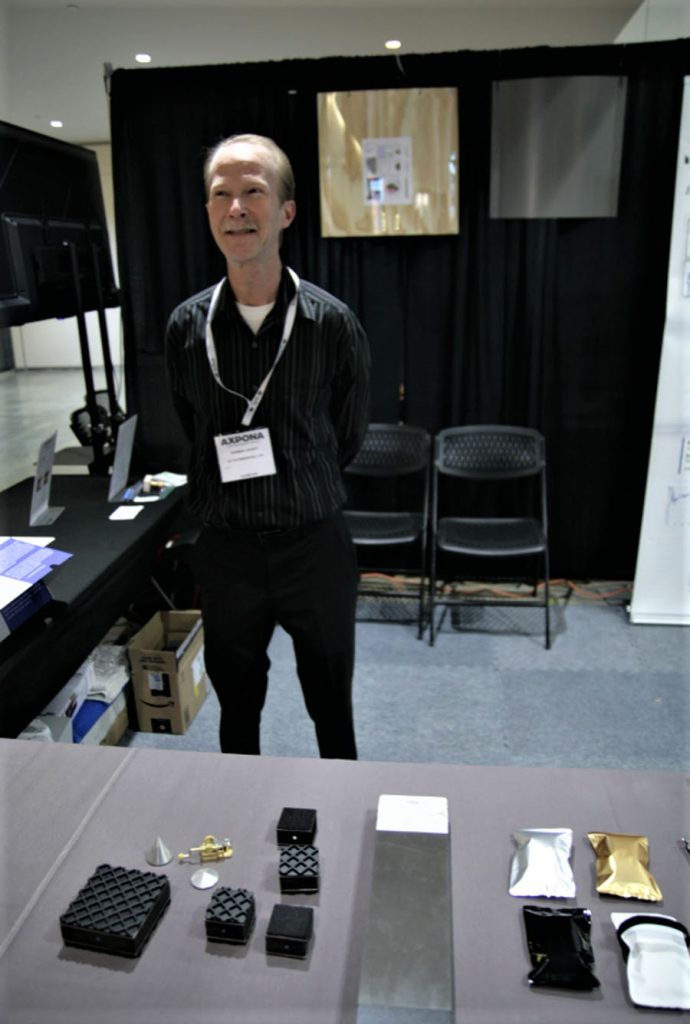
I visit with Norman Varney, Principal Consultant for A/V Room Service, Ltd. His Equipment Vibration Protector pads, which I previously reviewed, sit under my DAC, preamp, and phono stage preamplifier in my reference system at home. He pitches me on his speaker isolation pads, claiming that inserting them under my speakers will reduce sound transmission from my basement listening room to the main floor by isolating mechanical resonances, as the whole house is structurally connected.
Later I spy Mat Weisfeld, President of VPI Industries, who manufacture and provide turntables to many of the exhibits here (I own their Prime Scout), zipping around the Renaissance Hotel, greeting friends and acquaintances as he picks up a couple taco bowls in the cafeteria line off the main lobby for himself and Anne Bisson, a jazz vocalist who's singing in one of their rooms.

"She's got to keep her strength up," he quips, as he walks briskly to the Convention center toting two heaping black plastic bowls. "See ya!"
I run into my friend, Michael, several times—twice solo and once with his wife, Amy, a music lover, quilter, and technical writer for a Fortune 500 company. Michael, who's a computer support specialist, plays rock guitar, collects and sells stereo equipment, owns a large vinyl collection, and is here writing for his own blog. He's euphoric.
"I'm staying all three days," he gushes on Friday, "No guts, no glory!"
Sunday's Score
And sure enough, I see Michael on Saturday and Sunday, as well, when Amy is with him at the Heretics loudspeaker exhibit.
"I can see that you're really excited," Amy exclaims, noting that I'll be picking up the Usher ML-801s for review in a couple hours.
Tom Vu, who employs the Ushers in Triangle Art turntable, phono stage and amplification demos at this show, packs the speakers and bases before I haul them via hand truck to the freight elevator, and then out to my SUV, with Joe's assistance.
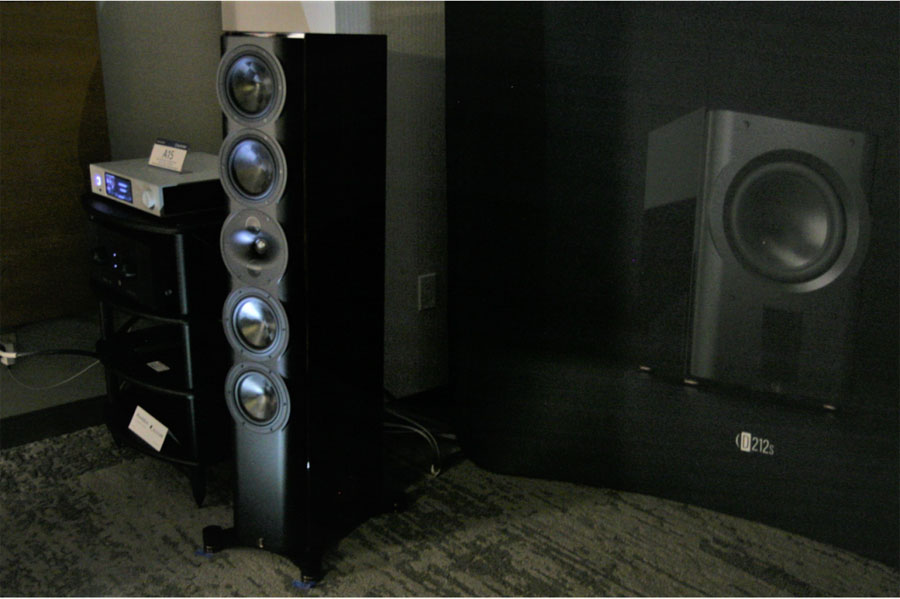
The Perlisten S7t loudspeakers
Regrets
There are things I regret missing, including a second, more thorough listening session with the Perlisten Audio S7t loudspeakers. They sounded rich and deep on an atmospheric, sonorous acapella vocal recording, but this wasn't enough of a reference point for evaluation during my brief visit on Friday. Then, in the mad rush to cover as much ground as possible before heading home to Belle's side, I simply forgot.
Straight Wire, Inc.'s president, Steven Hill, was only too happy to remind me via cellphone after AXPONA ended.
"What did you think of the Perlistens?" he asked. "They're made by true engineers!"
Founded by industry veterans with extensive experience at some of the top respected audio companies, PerListen Audio is the first audio company to feature THX Certified Dominus—the highest THX performance level—in its speakers, garnering them quite a buzz in the audio community.
Another exhibit I really missed was the new Avantgarde Trio horn loudspeakers. I heard that they were simply incredible. However, I can always catch them and more—much more—next year.
Well done
All in all, AXPONA 2022 was a wonderful experience. Seven thousand, nine hundred and ninety-six people attended, more than 500 companies were represented, and 140 rooms provided extraordinary portholes into the possibilities in this grand celebration of all things audio.
The doors had just closed on an elevator, when I overhead the following exchange between floors:
"It's wonderful!" a gray haired gentleman in a windbreaker and corduroy slacks effused. "I wish they held this show several times a year!"
"We'd never get anything done," deadpanned his his friend in a checkered Oxford shirt and jeans.
That's probably true, but nevertheless count me in with them in looking forward to AXPONA next year!

Qbuz's David Solomon poses with me at the close of this year's AXPONA




